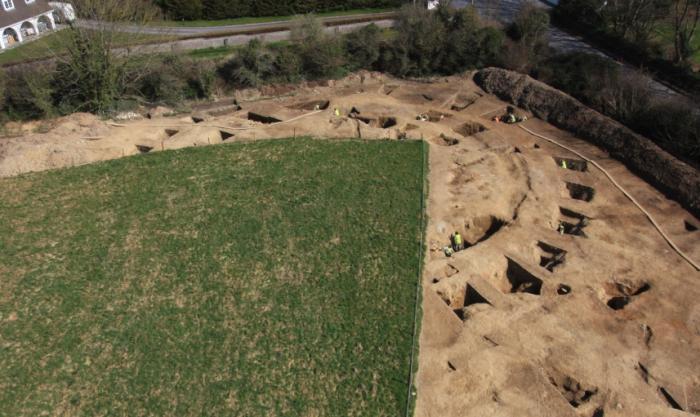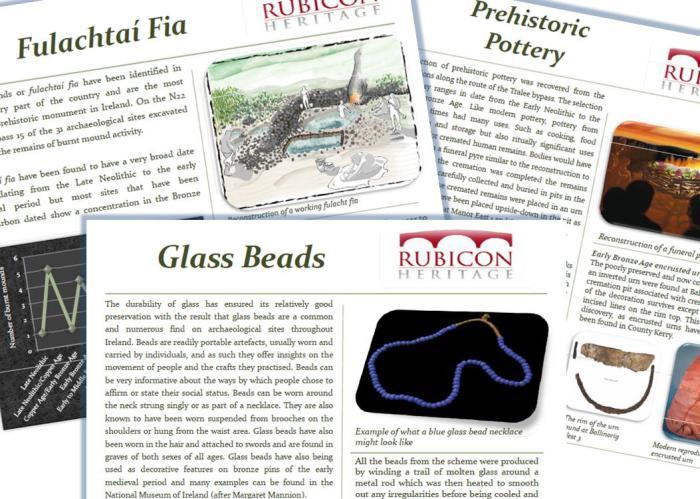Touring Tralee’s Past
By TII Archaeologist Sébastien Joubert
On the 25 January 2014, the general public were presented with the opportunity to learn about the archaeological discoveries made along the recently opened N22 Tralee Bypass during a free seminar entitled ‘Touring Tralee’s Past’, which was organised by the NRA and Kerry County Council. Speakers from Rubicon Heritage Services Ltd and Irish Archaeological Consultancy Ltd contributed to the afternoon event, which was hosted by the Kerry County Museum in Tralee.
During 2011, 37 archaeological sites ranging in date from the Late Mesolithic/Early Neolithic transition (c. 5000–4000 BC) to the post-medieval period (c. AD 1540–1700) were excavated along the 13.5-km long road scheme. These discoveries provided archaeologists with an opportunity to investigate sites providing evidence for Tralee’s past inhabitants. Their work has revealed new information on almost 6,000 years of life in this part of ‘The Kingdom’.

Patricia Long, Operations Manager with Rubicon Heritage Services Ltd, gave an overview of all of the findings made along the route of the bypass. James Hession, Senior Archaeologist with the same consultancy, presented more detailed accounts of several discoveries that were made in Ballinorig West, on the north-east outskirts of the town. These included open-air Bronze Age (c. 2400–600 BC) cooking places known as fulachtaí fia, prehistoric cremation burials such as an Early Bronze Age urn burial at Ballinorig West 3 and an early medieval double-ditched enclosure at Ballinorig West 2.
An Iron Age ring-ditch at Ballinorig West 4 was 4.3 m in diameter and had a causeway entrance on the eastern side. Several cremation burials were placed in the soil within the ditch and in the interior of the ring-ditch. Cremations pits were also found within the environs of the monument. The burials represented the remains of at least 10 individuals and ranged in date from the mid-fourth to the mid-first century BC.

A number of blue glass beads were retrieved from one of the cremation burials at Ballinorig West 4. The beads, which average 2 mm in diameter, may have been strung together as a necklace or could have been sewn on to clothing. Three of them with evidence of burning probably adorned a corpse on a cremation pyre.
The early medieval double-ditched enclosure at Ballinorig West 2 averaged 45 m in diameter. This site was unknown prior to the project and represents the remains of a ringfort that was occupied by a farming family about 1,200 years ago. More than 2,000 ringforts have been recorded in County Kerry by the Archaeological Survey of Ireland and the Ballinorig West 2 example is a significant addition to the small number of Kerry ringforts that have been scientifically excavated.

Shane Delaney of Irish Archaeological Consultancy Ltd described the excavations carried out on the northern plain of the River Lee at Manor East, where several waterlogged remains were excavated near what would have been crossing points during the late Iron Age/early medieval period. Colm Moloney, Managing Director of Rubicon Heritage Services Ltd, concluded the presentations by detailing some of the fascinating discoveries made in both Ballingowan and Manor East, on either side of the existing Tralee–Killarney road, and highlighted the significance of the evidence for a potential prehistoric ceremonial avenue identified there.
The final part of the seminar was dedicated to the description of the artefacts uncovered during the excavations and, thanks to the cooperation of the National Museum of Ireland, many of these were displayed at the County Museum during the day. People who could not attend the talks had the opportunity to come and view the objects and learn about their significance from the excavators and museum staff. The artefacts on display included stone axeheads and other stone tools, glass beads and several types of prehistoric pottery. These included two types of pottery not previously identified in County Kerry: 5,000-year-old Neolithic globular bowls and the remains of a 4,000-year-old encrusted urn.

One of the oldest finds exhibited was a Neolithic polished stone axehead that was found within a stake-hole at Manor East 1. This limestone axehead measures 85 mm in length and it would have been hafted in a wooden handle originally. The earliest farmers who settled this area almost 6,000 years ago would have used axes like this to clear woodland and for carpentry.
‘Touring Tralee’s Past’ was a very successful, well-attended event. The seminar brought information on these recent archaeological discoveries to the local community, enhancing their appreciation of the archaeological heritage in the Tralee area and highlighting the measures that TII (formerly the NRA) takes to protect that heritage in advance of road construction. This seminar was another step along the way to integrating these new discoveries into the existing narratives of the archaeology of County Kerry. TII was delighted to be able to partner with the Kerry County Museum to do this and looks forward to continuing this productive relationship.

Preparation of a TII monograph presenting the full results of the excavations on the Tralee Bypass is on-going, however, several articles summarising the findings have already been published in the Journal of the Kerry Archaeological and Historical Society (Series 2, Vol. 12, 2012) and in Seanda magazine (Issue 6 and Issue 8). Accounts of archaeological discoveries on two other road schemes in Kerry—the N69 Rea to Tullig and the N86 Annascaul to Gortbreagoge—have also recently been published in the Journal of the Kerry Archaeological and Historical Society.
(Originally posted 15 April 2014; updated 10 February 2016)